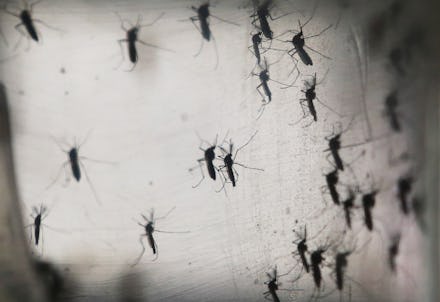Scientists Finally Have a Clear Image of the Zika Virus — And Now We Can Fight It

Scientists just took a massive step forward on the path to fighting the Zika virus.
Using an imaging technique called cryo-electron microscopy, a team of researchers from Purdue University and the National Institutes of Health were able to determine the structure of Zika, a flavivirus in the same family as West Nile virus, dengue and inflammation of the brain called encephalitis. Zika can be transmitted sexually, and evidence suggests it can lead to serious birth defects in babies.
The image of the virus is a major breakthrough. It lets us see how the virus is affected by treatment, rather than continuing to experiment with a cadre of therapies, a process not unlike throwing spaghetti on the wall to see if something sticks.
"In the design of antiviral compounds, we used to use enormous libraries [of compounds] to target the virus and see if it made an impact," Purdue University professor Michael Rossmann said in a phone call with Mic on Thursday. "Now we have the shape of the virus, and we aren't looking blind. ... If [a compound] works, we'll see it stop the virus."
With the new image of the virus, researchers could see where flaviviruses are attaching to human cells, shedding light on how the viruses attack humans and cause birth and brain problems.
What you're seeing above is actually tens of thousands of two-dimensional electron micrograph images pasted together to create a high-resolution 3-D image of the virus.
To create the image, the virus particles were frozen, then shot with high-energy electrons. Each of those shots is one of the thousands of image slices. It's painstaking, sure, but the result could help scientists figure out how to stop Zika.
This is an early step. Even with the image, Rossmann said, it will still take years to actually eradicate the virus.
But the early models like this one are promising. Shannan Rossi, a virologist from the University of Texas Medical Branch, introduced the first peer-reviewed publication of a mouse model for Zika infection as a way to show treatments that could work to combat flaviviruses. "Our model shines light on the efficacy of therapeutics against Zika infections, and allows us to screen which vaccines will be useful to fight Zika," Rossi said in an interview.
"This gives us a strict yes-or-no answer on if the vaccines will work, and that can be scaled to a lot of compounds in a short time," she explained.
Right now, Zika isn't a national pandemic. But according to the Centers for Disease Control, 312 travel-related cases have already popped up in the states, and finding treatment is more important now than ever.
"If Zika comes to America and sets up an infection cycle, the game will change," Rossi said. "It won't just be a traveler's disease, it'll be something you could get in your backyard. As the summer comes, that possibility gets higher. We just want to be as ready as we can."